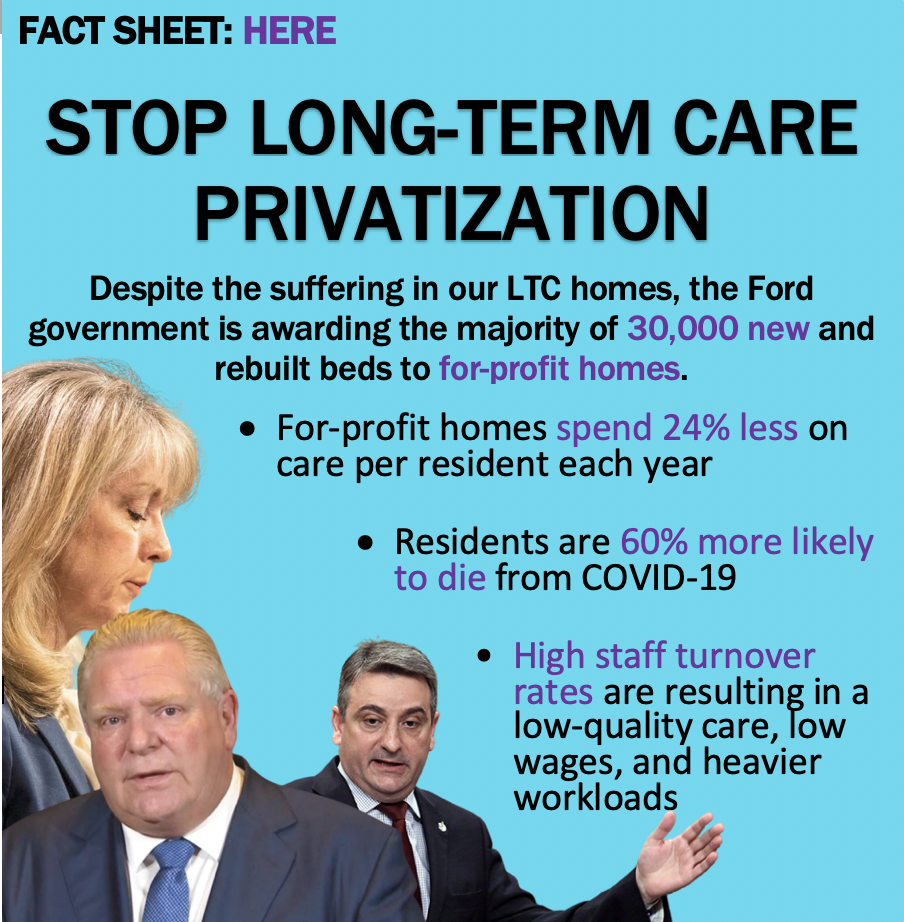
FACT SHEET: Why Stop the Privatization of Long-Term Care
Posted: March 8, 2022
(March 8, 2022)
How Long-Term Care is Being Privatized
There have been two big initiatives to privatize LTC in Ontario in recent decades:
In 1998, Ontario’s Conservative Mike Harris government built 20,000 new long-term care beds and allocated the majority of them to for-profit corporations, including large chain companies. This tipped the balance from a majority public and non-profit LTC in Ontario to a majority for-profit LTC. Mike Harris went on to become the chair of Chartwell, one of the large for-profit LTC chain companies.
Now, the Ford government is building more than 30,000 new and rebuilt LTC beds, and a majority of them are allocated to for-profit chains. The top ten bed winners are all for-profit chains, including those with the very worst records for resident deaths, negligence, and inadequate care.
Why LTC Should Not Be Private
Public money and residents’ fees go to profit versus care
All LTC homes are funded by the public through taxes and residents’ fees for their beds. For public and non-profit homes, money goes to improving care, programs, and services for residents. In municipal homes, additional property tax money goes into improving care levels and better wages and working conditions for staff.
For-profit homes spend 24% less per year on care for each resident than for non-profit homes. Profit is removed from public funding and residents’ fees for investors and shareholders. In fact, the for-profit chains report to their shareholders that they are taking tens of millions of dollars out of the homes in profits every single month.
The COVID-19 pandemic exposed horrific negligence in the for-profit homes compared to public and non-profit homes
- For-profit residents are 60% more likely to become infected with COVID-19 and 45% more likely to die than residents in non-profit homes.
- Death rates in for-profit homes were five times greater than those of publicly-owned homes, and double those of non-profits.
- Healthy residents reported being kept in rooms with residents with COVID-19, increasing their risk of infection.
For-profit homes have lower staffing and care levels and worse working conditions for staff
- There is no care without staff.
- For-profit LTC homes gain profits in part from setting low wages for staff.
- For-profit homes experience high staff turnover rates resulting in lower-quality care, lower wages, and heavier workloads.
- Compared to non-profit homes, for-profit homes hire more part-time and casual staff to avoid providing benefits and supports to workers.
For-profit LTC homes have poorer outcomes for their residents
- For-profit homes have more cases of diseases and ulcers, complaints, and transfers to hospitals.
- Residents in for-profit homes are 25% more likely to be hospitalized and 10% more likely to die than in for-profit homes.
- After spending three months in a for-profit LTC home, residents’ risk of being transferred to a hospital increases to 36%.
- Residents in for-profit homes are more likely to be hospitalized with pneumonia, anemia, and dehydration than non-profit LTC homes.
Click here for printable version


